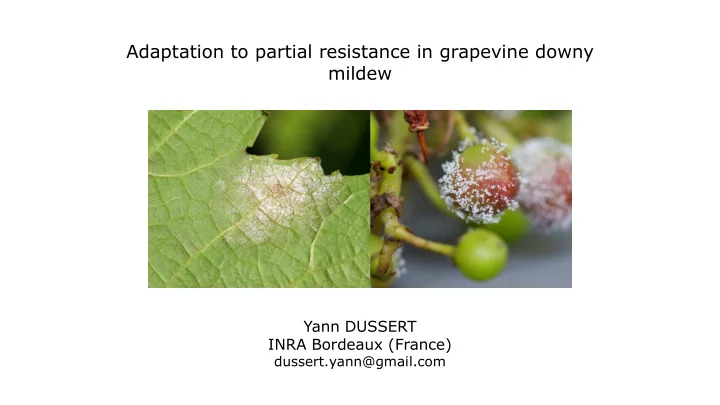

Adaptation to partial resistance in grapevine downy mildew Yann DUSSERT INRA Bordeaux (France) dussert.yann@gmail.com
Who did the work? INRA Bordeaux Acknowledgments François Delmotte GenoToul (sequencing & computing Isabelle Demeaux resources) Carole Couture Laurent Delière Funding Agence Nationale de la Recherche INRA Toulouse (GANDALF, EFFECTOORES, LabEx COTE), Jérôme Gouzy programme européen Innovine Ludovic Legrand Olivier Bouchez Claire Kuchly INRA Colmar Pere Mestre Marie-Christine Piron INRA Nantes Claude Rispe
The grapevine downy mildew Plasmopara viticola
Recent use of partially resistant cultivars Important yield loss for traditional cultivars Controlled using fungicides Recent breeding and use (15-10 years ago) of partially resistant grapevine cultivars Resistance QTLs from wild North-American and Asian grapevine species Represent a low percentage of cultivated grapevines
Adaptation of P. viticola to grapevine partial resistance Fast erosion of plant resistance Increase of pathogen aggressiveness Isolate from resistant cultivar Delmas et al. 2016, Evolutionary Applications Delmotte et al. 2014, Infection, Genetics and Evolution Dynamics of adaptation Isolate from susceptible cultivar What genes are involved? Population genetics approach with genome scans
A new high-quality reference genome Obtaining a better genome reference with PacBio sequencing at deep coverage (185x) PV221 v1 PV221 PacBio (Dussert et al. 2016) (Dussert et al. 2018) Assembly size (Mb) 74.8 93.0 Scaffold number 1886 359 Max. scaffold length 0.76 2.85 (Mb) N 50 (kb / nb. scaffolds) 180.6 / 130 706.5 / 38 Completeness (BUSCO) 92.8% (4.7% duplicated) 95.7% (1.7% duplicated)
A new high-quality reference genome + assembly of Plasmopara muralis , infecting wild grapevines ( Parthenocissus sp.) Repertoire of pathogenicity genes Genes under positive selection = adaptation to the grapevine host
A new high-quality reference genome
Adaptation to partially resistant grapevine 42 isolates (mean coverage: 30 to 110x) France Germany 3 wine-producing regions Collected on: Susceptible grapevine Switzerland Partially resistant grapevine (RPV3 QTL) 1.8 million SNPs (around 990,000 with Italy MAF < 0.1)
Phenotyping: aggressiveness of isolates on partially resistant cultivar Measured traits for the 42 isolates: • Sporangium production • Sporangium size • Latency period On two hosts: susceptible host (Cabernet Sauvignon) and partially resistant host (RPV3 cultivar) 8 replicates
Phenotyping: aggressiveness of isolates Number of sporangia / Sporangium production on mm² a partially resistant plant Isolates collected on susceptible vines Sporulation on sensible cultivar VS Isolates collected on resistant vines
Genetic structure & aggressiveness
Genetic structure & aggressiveness France Germany Switzerland Italy
Genetic structure & aggressiveness France Germany Switzerland Italy
Genetic structure & aggressiveness
Detection of genomic regions involved in adaptation to partial resistance Which genes are under selection? Multiple methods: • Regression of SNPs by principal components of PCA (PCAdapt, Luu et al. 2017) • F ST computed from allelic frequencies inferred with clustering (sNMF, Frichot et al. 2014) • X t X statistic (BayPass, Gautier 2015) Combined using approach of Verity et al. (2016): Mahalonobis distance on stats (Minotaur R package)
Outlier regions in combined selection tests Mahalonobis distance
Outlier regions in combined selection tests Mahalonobis Putative secreted effectors (CRN-like, elicitin) distance
On-going analyses More detailed analysis of outlier regions: • Genetic diversity, frequency spectrum • Effect of SNPs? (synonymous/non -synonymous/intergenic) • Linkage disequilibrium, haplotype structure Selection of the same genes for all aggressive isolates?
In summary New reference sequence of high quality for Plasmopara viticola
In summary New reference sequence of high quality for Plasmopara viticola Adaptation to partial plant resistance • Isolates with high aggressiveness on resistant plants are genetically differentiated, but not in one single group: independent adaptations • Detection of selected genomic regions: combination of multiple methods to find outliers (some interesting candidates)
Recommend
More recommend